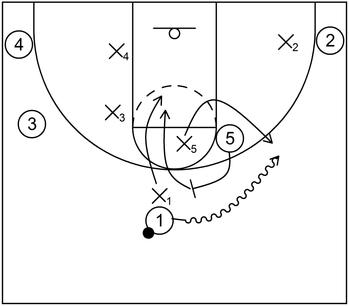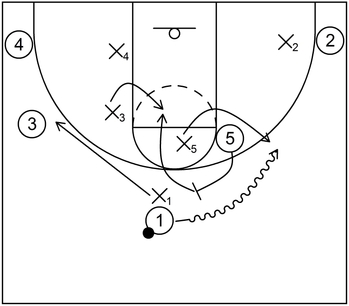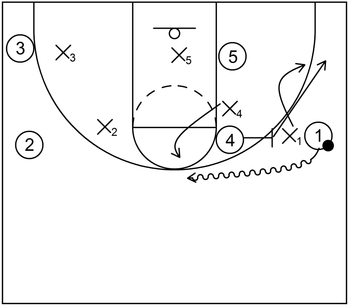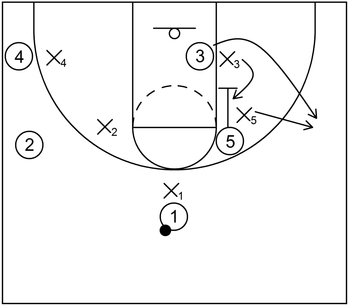What is switch defense in basketball
Switch defense, also known as defensive switching, is a basketball defensive tactic that occurs when at least two defenders exchange the offensive players that they are currently guarding to ultimately hinder or prevent offensive scoring opportunities near the basket or from the perimeter.
Which defensive teams could benefit from switching
Defensive teams that are versatile or flexible in terms of speed, quickness, and/or size could benefit from the switching defense tactic.
For example, defensive teams that possess bigger guards that can adequately defend the low post areas or defensive teams with post players that can sufficiently guard the perimeter areas could implement a switch defense to limit or prevent the scoring options of the offensive team.
What is an advantage of defensive switching
One noteworthy advantage of defensive switching is that it could cause mid-range or three-point scoring opportunities by way of off-ball or on-ball screens to become ineffective or completely useless.
Switching vs. off-ball screens
If the offensive team executes an off-ball screen, then the defender that is being screened could simply switch to the screener instead of attempting to fight through the screen or evade it in some other manner.
Additionally, the initial screener’s defender (i.e. the defender that is guarding the offensive player setting the screen) would also switch to the offensive player that is receiving the screen.
For example, in the case of a down screen, the defender that is being screened would simply switch to the down screener while the screener’s defender would switch to the offensive player receiving the down screen.
When this occurs, the switch defensive tactic could cause the down screen action to become ineffective. This, in turn, could reduce scoring opportunities, particularly from three-point range, for the offensive team.
Switching vs. on-ball screens
Generally speaking, outside of switching, when an on-ball screen occurs, particularly at the top or the wings, the defender being screened would fight through it or go under it while the screener’s defender would generally execute the tactics known as the defensive hedge or drop coverage to hinder the screen receiver or the screener.
Also, if the on-ball screen occurs near the wing, the defender being screened could also implement the ice defense tactic to take away the screen while the screener’s defender attempts to contain the player with the ball.
These particular tactics of hedging, drop coverage, or ice defense could be useful in their own ways, especially if the defensive team does not possess much versatility for switching in terms of perimeter or post basketball positions.
However, the downside of implementing those tactics, particularly against on-ball screens is that they could become susceptible to mid-range or three-point shooting possibilities by the offensive team.
For example, let’s say a defensive team implements the drop coverage or the ice defense tactic.
When that occurs, if the player with the ball is able to dribble into the gap between the screener’s defender and the on-ball defender, then that same player can take the mid-range jump shot.
Moreover, as another example, let’s say a defensive team implements the defensive hedge.
When that occurs, if the screener pops to another area on the perimeter that is away from the screener’s defender, the screener will most likely be able to take an open perimeter shot from mid-range or three-point range.
From that point, the screener’s defender will most likely not be able to execute an adequate defensive closeout in time to prevent an uncontested jump shot.
Defensive switching, on the other hand, could take away these potential mid-range or three-point jump shots or at least, influence the offensive player with the ball to take a contested jump shot after the switch occurs.
What is a disadvantage of defensive switching
One notable disadvantage of defensive switching is that it could result in defensive mismatches such as slower post players defending against quicker perimeter players or smaller perimeter players defending against bigger post players.
These types of opportunities could then be exploited by an offensive team that has one or more highly skilled players at their respective positions.
Therefore, defensive switching should usually be implemented consistently when defensive teams have versatile defenders on the court as mentioned in a previous section.
However, it should also be noted that it is possible to mitigate defensive mismatches to a degree with a three-man switch as mentioned in another section below.
Slow post players vs. quick perimeter players
As an example, let’s say a switch occurs after an on-ball screen and at this point, a defensive center is guarding a offensive point guard.
From that point, if that post player is slower than the offensive point guard, then that same point guard could call for an isolation play to break down that defensive center.
Following that, the point guard on offense could then get dribble penetration which could lead to the point guard scoring at the basket themselves or a possible kick out three-point opportunity for another offensive teammate.
In addition to that, even if the point guard does not necessarily gain dribble penetration, that player could still break down the slower defensive center and create a scoring opportunity such as a step-back three-point shot.
Bigger post players vs. smaller perimeter players
As another example, let’s say the defensive switch occurs again but this time, it was an off-ball pin down screen between an offensive center and a defensive shooting guard.
In other words, the defensive shooting guard switched onto a highly skilled offensive center after the pin down screen near the basket.
If that were to occur, then the offensive team could get the ball to that same center, either by way of a post entry pass, generally from the wing, or via a high low action from the top.
Afterwards, there would most likely be a very high chance that the defensive shooting guard would get scored on near the paint by the offensive center in this instance.
What is a potential strategy to mitigate defensive switch mismatches
One potential strategy that could be used to mitigate defensive switch mismatches is for the defensive team to implement a three-man switch.
This three-man switch could be very useful against the pick and roll in certain situations and as an added bonus, it could diminish the potential chances of the offensive team exploiting defensive mismatches, specifically near the basket.
As an example, let’s say that the offensive player who initially set the screen rolls to the basket but the switching player (that switched to become an off-ball defender) is smaller than that same screener.
When that occurs, the defensive team could execute a three-man switch. Therefore, to start, the initial switching action would occur between the original on-ball defender and the screener’s defender as previously stated.
Yet, what would then happen is another off-ball defender (a third defender) on the opposite side of the screen, that is preferably bigger than the initial on-ball defender would switch to the offensive player rolling to the basket.
After that, the initial on-ball defender would switch to the third defender’s assignment that is preferably near the perimeter.
To further clarify, let’s say a defensive point guard is the initial on-ball defender guarding the offensive team’s point guard at the top and that same defender gets screened by the offensive team’s center.
From that point, let’s also say the offensive point guard begins to dribble towards the right side after the initial screening action occurs.
However the screener’s defender, presumably a defensive center counters the initial screening action by switching to the offensive team’s point guard.
Furthermore, at the same time, the defensive team’s point would normally switch to the offensive team’s center.
Unfortunately though, for the defensive team, if that offensive center rolls to the basket, then the defensive point guard would typically be at a significant disadvantage in most instances.
So, to mitigate this from occurring, the defensive team could utilize a third defender, preferably near the left side’s perimeter wing or corner (for this case) and ideally one that is bigger than the defensive point guard.
From there, that same third defender could switch to the center while the point guard switches to the third defender’s assignment, near the perimeter if possible.
As a result of that, the defensive team could potentially eliminate an uncontested three-point jump shot as well as hinder offensive productivity near the low post areas.
Which systems or strategies typically implement the switch defense tactic
The switch defense tactic is typically implemented within a type of basketball defensive system known as man to man defense as well as the run and jump defensive strategy.
Man to man defense
In man to man defense, each defender covers a specific offensive player. Therefore, defensive switching could become a viable option, especially as a countermeasure against both the on-ball or off-ball screens by the offensive team.
The main reason that switching could be a potentially effective defensive tactic in this situation is because the two defenders that should execute the switch would still be guarding a specific offensive player.
The primary difference is that those two defenders simply switched or interchanged which offensive players that they were originally defending against.
Run and jump defense
Within the run and jump defensive strategy, switch defense is generally referred to as a jump switch and it typically occurs between an on-ball backcourt defender and an off-ball backcourt defender if the player with the ball decides to dribble down the middle of the court.
Essentially, the run and jump is usually initiated after a basket gets made and the team which scored then transitions from offense to defense. From that point, an on-ball defender does not initially implement defensive pressure.
Instead, that same defender would be in a defensive stance just below the backcourt three-point arc and allow the offensive player that receives the inbound pass to either dribble towards the middle or dribble towards the sideline.
Furthermore, as that happens, there will be an off-ball defender that is also in the backcourt, generally below the on-ball defender and near the opposite sideline.
From that point, if the player with the ball dribbles down the middle, then the off-ball defender will jump switch to that same player in possession of the ball while the initial on-ball defender jump switches to the off-ball defender’s original assignment or another assignment in certain instances.
What are simple diagram examples of switch defense
Example 1

This is an example of switch defense during pick and roll action from the top. To begin, 1 dribbles toward the right side of the court via the on-ball screen set by 1.
However, as that happens, the screener’s defender, X5 switches to 1 while the initial on-ball defender, X1 switches to 5 rolling to the basket.
Example 2

This is an example of switch defense during pick and roll action from the top. Furthermore, this example also includes a three-man switch to mitigate a potential defensive mismatch.
To begin, 1 dribbles towards the right side of the court via the on-ball screen set by 5. However, as that occurs, X5 switches onto 1.
Furthermore, at the same time, X3 switches onto 5 rolling to the basket while X1 switches onto 3 near the left side wing.
Example 3

This is an example of switch defense during pick and pop action from the right side wing. To start, 1 dribbles toward the top via the on-ball screen set by 4.
As that occurs, X4 switches onto 1. At the same time, 4 pops to the right side corner and as that happens, X1 switches onto 4.
Example 4

This is an example of switch defense when the offensive team executes an off-ball screen. To begin, 3 cuts to the right side wing via the down screen set by 5.
As that happens, X5 switches onto 3 while X3 switches onto 5 as a counter to the screening action.